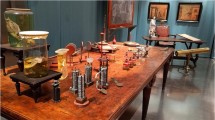Abstract
Augmented Reality (AR) promises to enhance motivation and learning of museum visitors, whereby head-mounted displays (HMD) provide a greater presence and immersion than handheld devices (HHD). To assess this, we transferred interactive AR stories from an existing HHD prototype to the MS HoloLens 2. The app lets museum visitors of a Roman fort ‘meet’ video ghosts to learn about life at their historic location. We compared two alternative ways to trigger spatial videos. The evaluation shows that, while limitations occur when reusing media once produced for 2D screens on HMDs, the approach is worth focusing on. The HMD enhances the immersion even with 2D videos placed in space, thus granting virtual ghosts more ‘presence’ in the user experience.
Access this chapter
Tax calculation will be finalised at checkout
Purchases are for personal use only
Similar content being viewed by others
References
Kampa, A., Spierling, U.: Smart Authoring for location-based augmented reality storytelling applications. In: Eibl, M., Gaedke, M. (eds.) INFORMATIK 2017. Gesellschaft für Informatik, Bonn, pp. 915–922 (2017). https://doi.org/10.18420/in2017_93
Spierling, U., Winzer, P., Massarczyk, E.: Experiencing the presence of historical stories with location-based augmented reality. In: Nunes, N., Oakley, I., Nisi, V. (eds.) ICIDS 2017. LNCS, vol. 10690, pp. 49–62. Springer, Cham (2017). https://doi.org/10.1007/978-3-319-71027-3_5
Liu, Y., Spierling, U., Rau, L., Dörner, R.: Handheld vs. head-mounted ar interaction patterns for museums or guided tours. In: Shaghaghi, N., Lamberti, F., Beams, B., Shariatmadari, R., Amer, A. (eds.) INTETAIN 2020. LNICSSITE, vol. 377, pp. 229–242. Springer, Cham (2021). https://doi.org/10.1007/978-3-030-76426-5_15
Geronikolakis, E., Papagiannakis, G.: An XR rapid prototyping framework for interoperability across the reality spectrum, ArXiv, abs/2101.01771 (2021)
Chan, B.Y., Ismail, Z.I.B.A., Jack, L.P., Asli, M.F.: Augmented reality mobile application. A feasibility study in a local national museum. J. Phys. Conf. Ser. 1358. 12th Seminar on Science and Technology 2–3 October 2018, Kota Kinabalu, Sabah, Malaysia, IOP Publishing Ltd. (2019). https://doi.org/10.1088/1742-6596/1358/1/012057
Choi, H., Kim, Y.R., Kim, G.J.: Presence, immersion and usability of mobile augmented reality. In: Chen, J.Y.C., Fragomeni, G. (eds.) HCII 2019. LNCS, vol. 11574, pp. 3–15. Springer, Cham (2019). https://doi.org/10.1007/978-3-030-21607-8_1
Hou, W.: Augmented reality museum visiting application based on the Microsoft HoloLens. J. Phys. Conf. Ser. 1237, 052018 (2019). https://doi.org/10.1088/1742-6596/1237/5/052018
Sugiura, A., Kitama, T., Toyoura, M., Mao, X.: The use of augmented reality technology in medical specimen museum tours. Anat. Sci. Educ. 12(5), 561–571 (2018). https://doi.org/10.1002/ase.1822
Kim, D., Seo, D., Yoo, B., Ko, H.: Development and evaluation of mobile tour guide using wearable and hand-held devices. In: Kurosu, M. (ed.) HCI 2016. LNCS, vol. 9733, pp. 285–296. Springer, Cham (2016). https://doi.org/10.1007/978-3-319-39513-5_27
O’Dwyer, N., Zerman, E., Young, G.W., Smolic, A., Dunne, S., Shenton, H.: Volumetric video in augmented reality applications for museological narratives. J. Comput. Cult. Heritage (JOCCH) 14, 1–20 (2021). https://doi.org/10.1145/3425400
Pillai, J.S., Ismail, A., Charles, H.P.: Grammar of VR storytelling: visual cues. In: Proceedings of the Virtual Reality International Conference-Laval Virtual, pp. 1–4 (2017). https://doi.org/10.1145/3110292.3110300
Syrett, H., Calvi, L., van Gisbergen, M.: The oculus rift film experience: a case study on understanding films in a head mounted display. In: Poppe, R., Meyer, J.-J., Veltkamp, R., Dastani, M. (eds.) INTETAIN 2016 2016. LNICSSITE, vol. 178, pp. 197–208. Springer, Cham (2017). https://doi.org/10.1007/978-3-319-49616-0_19
Gödde, M., Gabler, F., Siegmund, D., Braun, A.: Cinematic narration in VR – rethinking film conventions for 360 degrees. In: Chen, J.Y.C., Fragomeni, G. (eds.) VAMR 2018. LNCS, vol. 10910, pp. 184–201. Springer, Cham (2018). https://doi.org/10.1007/978-3-319-91584-5_15
Hevner, A., Chatterjee, S.: Design Research in Information Systems: Theory and Practice. Springer, New York (2010). https://doi.org/10.1007/978-1-4419-5653-8
Nielsen, J., Landauer, T.K.: A mathematical model of the finding of usability problems. In: Proceedings of ACM INTERCHI'93 Conference, Amsterdam, The Netherlands, pp. 206–213 (1993). https://doi.org/10.1145/169059.169166
Acknowledgements
This work has been funded (in part) by the German Federal Ministry of Education and Research (BMBF), funding program Forschung an Fachhochschulen, contract number 13FH181PX8. We would like to thank Yu Liu and Linda Rau for their inspiration and implementation advice. All video assets were produced within the project “Spirit” [2].
Author information
Authors and Affiliations
Corresponding author
Editor information
Editors and Affiliations
Rights and permissions
Copyright information
© 2022 ICST Institute for Computer Sciences, Social Informatics and Telecommunications Engineering
About this paper
Cite this paper
Bitter, J.L., Spierling, U. (2022). Towards Mobile Holographic Storytelling at Historic Sites. In: Brooks, E., Sjöberg, J., Møller, A.K. (eds) Design, Learning, and Innovation. DLI 2021. Lecture Notes of the Institute for Computer Sciences, Social Informatics and Telecommunications Engineering, vol 435. Springer, Cham. https://doi.org/10.1007/978-3-031-06675-7_9
Download citation
DOI: https://doi.org/10.1007/978-3-031-06675-7_9
Published:
Publisher Name: Springer, Cham
Print ISBN: 978-3-031-06674-0
Online ISBN: 978-3-031-06675-7
eBook Packages: Computer ScienceComputer Science (R0)




